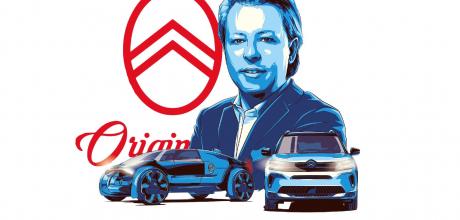The car inquisition Pierre Leclercq, Citroën design chief
Citroën’s focus on value doesn’t mean it has to be boring, insists its design chief. By Jake Groves.
‘AFFORDABLE? WE MAKE IT SEXY’
Here’s a new way of looking at Citroën: it’s the IKEA of car brands. You may scoff, but Citroën’s suave and deep-thinking design chief Pierre Leclercq’s admires the Swedish furniture company’s designers and likes the way IKEA has brought good design to more people.
‘My parents probably had the choice of maybe two or three kitchens and they all looked alike somehow,’ he says. ‘Design isn’t a luxury any more – you don’t have to pay for it. With car design, it’s the same. For example, with the Ami, it didn’t have to look like shit just because it was cheap – it has to look great. We want people to come out in the morning and think, “I like this view.” Affordable?
Cost effective? Great. But we have to make it super sexy.’ Leclercq has been in the car industry since 2000. After a period at Ford’s Ghia studio in Italy his big break came with the BMW Group, working in California and Munich. In the middle of the Bangle era, Leclercq was the design lead on the first X6, then he became head of design for M division.
‘The German car industry is an amazing school,’ he says. ‘The way you learn to become a designer is something that’s really important, and the freedom you have to work on those proportions there – it’s something that shapes you for any job.’
Citroën has always been in Leclercq’s life. ‘I grew up in a Dyane – my mother had a red one – and my dad had a CX, and then my grandfather had a DS and a GS – there was a lot of Citroën around me as a kid.’ Like his former bosses Linda Jackson (now head of Peugeot) and Vincent Cobée (who stepped down in February), Leclercq’s devotion to the Citroën cause is absolute.
‘We are the brand that has to make mobility affordable. When you’re in a group of so many brands, you have to fight for what is right,’ he says. ‘Think of Ami – it’s courageous that a brand put that on the road. I’m super happy to work for a brand that made something that wasn’t a promised success.
Of course it won’t be with Ami that we’re making enough money for the company to survive, but with our products we make people’s lives better. It’s the same with Oli – it’s not just a styling exercise.’
Leclercq wants Citroën to get more ‘technical’ in its design, like last year’s facelifted C5 Aircross being the future look of production cars. ‘Think more consumer electronics with how we treat things like headlights and grilles. This is the start of something we’re going to continue to explore in every car that I really believe will give us much more chance to be successful in terms of sales.’
But despite that push for modernity, the company has turned to the past for its latest corporate logo. ‘It’s definitely retro, isn’t it? And yet to me it looks so modern. We tried it first on the “1919” concept car, and we thought it looked pretty cool and would try it out on projects we were working on in the studio. I wouldn’t say everyone was convinced – we had to work on the proportions and, while it might look like the original logo from 1919, we actually did a lot of work to fine tune.’
Much of what Leclerq is championing comes together in the Oli concept, which combines low cost – using strengthened cardboard in its construction – with a more technical design. Leclercq clearly relished the task of creating an affordable but attractive car, and is scathing about those who are less ambitious: ‘When you try to make a car look normal but cheap, it’s going to be a failure, or at least not very interesting.
‘If you take Oli and the way we’ve done it to make it cost effective like a 2CV, the design engineering around the car is unbelievable. It’s cost effective. Functional. Beautiful. It’s a very difficult exercise to do today, but I think if you can bring a little bit of that into products that are affordable but sexy, then that is true to the DNA of the brand – that is a success.’
Leclercq favours offering more scope for personalisation, too. ‘How do we make our cars adaptable in the future? Customisation, modularity… it’s an area that’s extremely important for us to think about. If I think of what IKEA does, that inspires me in the way that they approach their collections – why not add a little of that into the car industry?’
Ami and Oli show the wacky, innovative side is still alive.
‘WITH AMI, I THINK IT’S COURAGEOUS THAT A BRAND WANTED TO PUT THAT ON THE ROAD’


